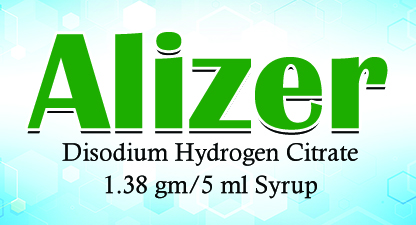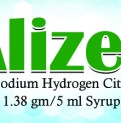ALIZER
Disodium citrate, more properly, Disodium Hydrogen Citrate is an acid salt of citric acid with the chemical formula Na2C6H6O7. It is used as an antioxidant in food as well as to improve the effects of other antioxidants. It is also used as an acidity regulator and sequestrant.
Disodium citrate may be used in patients to alleviate discomfort from urinary tract infections.
- Categories : Urinary Alkalizer
- Share Now :
ALIZER
Generic Name: Disodium Hydrogen Citrate
Therapeutic Category: Urinary Alkalizer, Systemic Alkalizer
Pharmacological Class: Alkalinizing agent
Composition: Each 5 ml contains Dihydrogen Sodium Citrate BP 1.38 gm
Pregnancy Category: A
Presentation: Available in 100 ml bottle with a measuring cap
Mechanism of Action
As Urinary Alkalizer
Renal acid-base regulation- Kidneys helps regulating blood pH by secreting H+ and absorbing HCO3-.
- When you take sodium citrate, it moves through your body.
- When it reaches your liver, it is converted to bicarbonate, a usable form of base in the body.
- This helps change the pH in your urinary tract from acidic to more basic.
- By reducing the acidity of the urinary tract, you can experience a reduction in symptoms.
In reduction of stone formation
As an added bonus, citrate can bind with acidic materials in kidneys to prevent calcium oxalate stones from forming.
- A rise in urinary pH increases the solubility of Cysteine in the urine and the ionization of Uric Acid to more soluble urate ion.
- By maintaining alkaline urine, the actual dissolution of uric acid stones may be accomplished.
Indications
- Acidosis following diarrhea
- Painful/Burning Micturition* (UTI)
- Renal Tubular Acidosis
- Uremic Acidosis (Hyperuricemia*)
- Kidney stones
Dosage
Route of administration: Oral
Adults: 5-10ml three times a day
Children: 2.5-5ml three times a day
Medication to be taken after meals
Pharmacokinetics
Absorption: Reaches maximum concentration in 1-2 hours
Metabolism: Citrate is metabolized to bicarbonate in the liver and plays a role as an intermediate in the citric acid cycle
Route of elimination: Largely eliminated through hepatic metabolism with very little cleared by the kidneys
Half-life: 18-54 minutes
Adverse Effects
Mild diuresis, stomach cramps, flatulence, diarrhea, GI ulceration, metabolic alkalosis, anxiety, mood swings
Contraindications
ALIZER is contraindicated in the following populations and situations:
- Hypersensitivity to any component of the formulation
- Patients on sodium restricted diets
- Hypertension
- Oedema
- Hyperosmolar states
Precautions
Hypoventilatory states*, Alkalosis*, Hypocalcaemia*, Neonates, Renal impairment, Cardiac Failure, Hypertension, Pulmonary Oedema, Monitor Serum Electrolytes.
Drug Interactions
- Enhances elimination of salicylates and barbiturates
- Additive effect with sodium retention caused by corticosteroids.
- Potentiates renal excretion of tetracycline.
- Hypochloraemic alkalosis* may occur with concomitant Potassium depleting diuretic
*Terminologies:
Micturition: The act of passing urine; urination.
Hyperuricemia: An excess of uric acid in the blood
Hypoventilatory states: Breathing at an abnormally slow rate, resulting in an increased amount of carbon dioxide in the blood.
Alkalosis: An excessively alkaline condition of the body fluids or tissues, which may cause weakness or cramp.
Hypocalcaemia: Deficiency of calcium in the bloodstream.
Hypochloremic alkalosis:A metabolic disorder resulting from an increase in blood bicarbonate level secondary to loss of chloride from the body.


